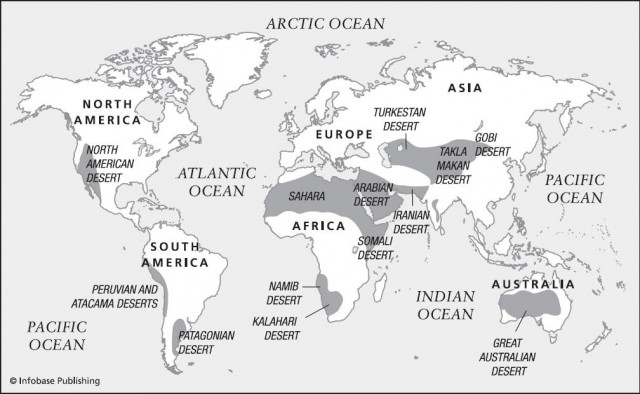Origin of the Landform: Deserts
T he appearance and evolution of Earth's deserts offer deep insights into geology, history, evolution, climate, and the whole rich history of the planet. Although deserts now cover great swaths of Earth's surface along the broad, hot midsection of the planet, most modern deserts are new landscapes—the transformation of grasslands and woodlands into an austere and revealing terrain that makes special demands of any living creatures who brave it and often thrive.
Although the deserts of North America seem vast in their sprawl across more than 500,000 square miles (1,295 sq km), they're dwarfed by the 3.5 million square miles (7.8 million sq km) of the Sahara Desert, the 1.3 million square miles (3.4 million sq km) of the Australian deserts, or the 1 million square miles (2.6 million sq km) covered by the Arabian deserts.
Generally defined as an area where annual evaporation from the surface exceeds annual rainfall, deserts are the result of a combination of position on the globe, local terrain, and global atmospheric circulation. Most of the deserts of the world lie between 15 and 35 degrees latitude, generally centered over the tropic of Cancer and the tropic of Capricorn. This midsection of the planet receives the most annual sunlight. The energy from the sun heats the air, especially along the equator. This heated air can hold an enormous amount of water. As it rises, much of that water condenses into clouds, which rain down upon the narrow belt of tropical rain forests along the equator, generally about 30 degrees latitude on either side of the equator. Now wrung out, the dry air moves both north and south, cooling as it moves. Eventually, it is cold and heavy enough to descend back down to the surface, creating the dry, wind-prone zones in which most of the Earth's deserts form.
This global circulatory pattern makes most deserts possible, but other factors have to combine to create the perfect conditions for a major desert. As a result, the world's deserts fall into several major types.

Rain Shadow Deserts
Many deserts form in low-lying regions that lie in the rain shadow of a major mountain range. Often, such desert-forming mountain ranges lie along coastal regions. When moisture-laden air moves inland off the ocean, it encounters the barrier of the mountains. As the moist air rises to move over the mountain range, it cools so that it can no longer hold all that moisture. The water falls as rain and snow on the mountains so that by the time the air moves into the low-lying regions beyond, it is dry and thirsty. To one degree or another, this rain shadow effect has created all of the deserts of North America.
Coastal Deserts
Coastal deserts form on the western edge of continents near the tropic of Cancer and the tropic of Capricorn largely as a result of great currents in the ocean. These great rivers in the ocean move in a great clockwise pattern in the Northern Hemisphere and in a counterclockwise direction in the Southern Hemisphere. Some of those currents start at the poles as heavy, chilled water sinks and flows along the western edges of the continents toward the equator. However, on the eastern edge of most of the continents, those currents flow in the opposite direction, moving warm tropical water toward the frigid poles. The cold currents that flow along the west side of most continents do not release water easily to the atmosphere, which means that the coastal areas next to such currents are often starved for water. This helps explain the high, cold, desperately dry deserts of Chile, which lie just opposite the lush rain forests of Brazil.

Interior Deserts
The final major type of desert forms in remote, interior regions, so far from the ocean that they are cut off from a ready supply of atmospheric water. Water from the warm tropics or the wet oceans that enters the atmosphere drops out as rain long before it reaches these vast interior spaces, which form the harshest deserts on the planet, including the vast Sahara and the Turkestan and Gobi deserts of Asia.
So the locations and dynamics of the world's deserts illuminate vital questions about everything from the positions of the continents to the workings of the climate of the entire planet. For instance, the dramatic increase in the extent of deserts worldwide in recent centuries holds important clues about the impact of human beings on the environment and future shifts in climate.
All of which makes understanding the history, evolution, dynamics, and geology of the deserts essential to understanding the history and fate of both the planet and human beings.